Lake Sweetwater History




Lake Sweetwater was constructed in 1929 and 1930 at a cost of about $450,000 [that would be 5.75 million in today’s dollars] near the town of Sweetwater, Texas in northeastern Nolan County by damming Bitter Creek. Nearby lookouts, clubhouse, and golf course were built later by 200 Civilian Conservation Corps workers. In 1934 the lake area below the dam had an open amphitheater, two fish hatcheries, and a baseball field. Above the dam was a rock clubhouse, a boat pier, a nine-hole golf course, and a suspension footbridge over the lake. Around the water's edge were a fishing pier, several lookout houses, picnic units, camping areas, gravel walkways, and rock bridges. Later a paved road was built around the lake.
Handbook of Texas Online, s.v. , http://www.tshaonline.org/handbook/online/articles/LL/rol73.html (accessed October 11, 2008).

Early History of Lake Sweetwater
by Travis Monday
[Excerpt from the book “Ultimate Museum Musings” by Travis Monday. Used with permission.]
“Sweetwater practically has solved its water problems for all-time, regardless of the growth of the city.” 1 Believe it or not, these words of optimism were part of an article in the Sweetwater Daily Reporter on September 7, 1932, shortly after the completion and filling of Lake Sweetwater.
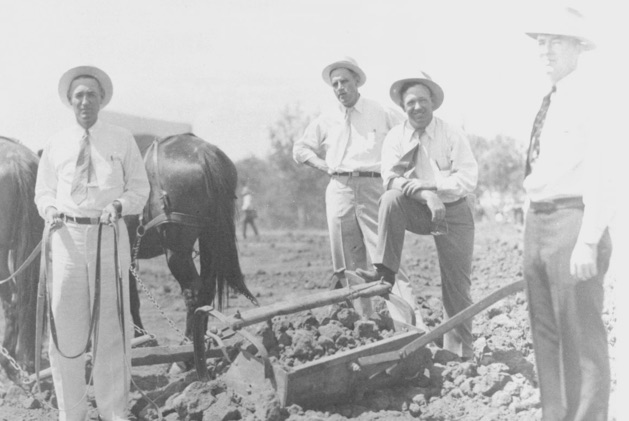
Breaking ground for Lake Sweetwater in December, 1929. The men in this photo, from left to right, are:
Marshall Pior, D. A. Clark, Luther Watson, and Lennie Armor
(Photo courtesy of the Pioneer Museum in Sweetwater, Texas).
The bond election for the building of a new lake in Nolan County passed on April 12, 1929.2
When Lake Trammell had been built in 1914, it was viewed as the answer to Sweetwater’s water woes, but a drought in 1927-28 left the lake almost dry, and local citizens realized that it was no longer adequate for their needs.3
According to an article in the Nolan County News on Sunday, June 10, 1934, “Lake Trammell was practically dry in 1927-8 and the principal water supply was coming from Santa Fe as an emergency source.” The same article indicated that Sweetwater also had 13 wells, known as Watt wells, 4 1/2 miles south of Roscoe.
Sherman Driggers remembers that his father-in-law, John Lynch, owned part of the land on which Lake Sweetwater was built.
Work on Lake Sweetwater began in December, 1929 and was completed, a year later, in December, 1930.4 The city accepted the lake from contractors on January 12, 1931.5
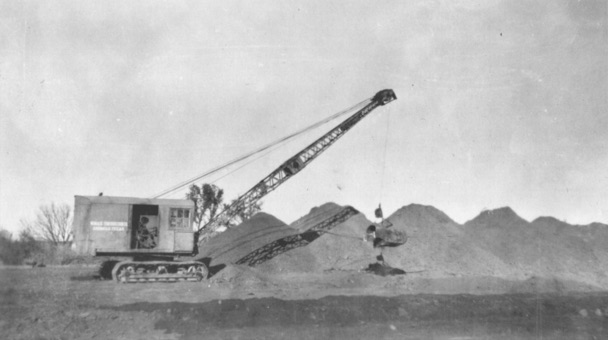
This photo, taken on December 27, 1929, shows a worker in a crane excavating the core trench
for Lake Sweetwater (Photo courtesy of the Pioneer Museum in Sweetwater, Texas).
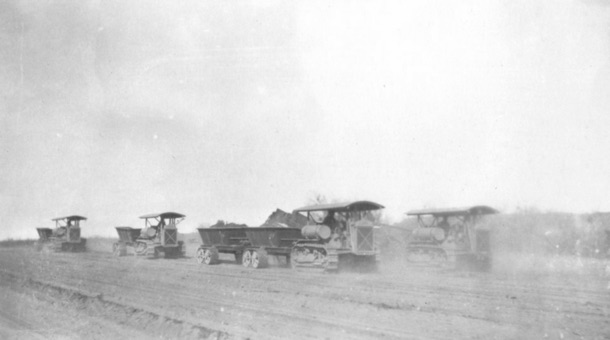
This photo, taken December 27, 1929, shows more of the equipment
used to build Lake Sweetwater (Courtesy of Pioneer Museum).
The first stage of the work was followed by many improvements designed to make Lake Sweetwater a popular site for recreation.
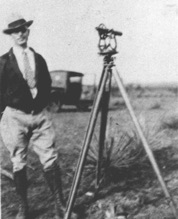
Stanley Morris remembers his father, J. C. Morris, Jr., serving as Sweetwater’s first city engineer during the building of Lake Sweetwater. “He ran the WPA workers out there who built all of the rock houses and lookouts and the little shelters around the golf course,” said Morris. His father also worked on the Aycock Submerged Dam that was built near the Lake Trammell Dam.
Sweetwater City Engineer
J. C. Morris, Jr., while surveying
for Lake Sweetwater in October, 1930
(Courtesy of the Pioneer
Museum in Sweetwater, Texas).
Sweetwater-resident Patsy (Armstrong) Hefner remembers living at Lake Sweetwater for a couple of years while many of the improvements were in progress. Her father, Walter William Armstrong, worked as the lake keeper during part of the time that there was a Civilian Conservation Camp near the dam.
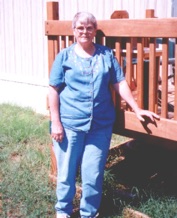
“The whole family went and we lived in the house and then the CCC Camp was moved in,” said Hefner. “They said, ‘We’re going to have swimming and we’re going to have boating and we need bathhouses and rest rooms.’ So they did the rock work -- built a rock wall around the house. They rocked the walls of the house on the outside; didn’t enlarge it, just rocked it.”
Hefner also remembers that her father was given a pony to ride in the areas of the Lake where there were no roads so that he could check for fishing and hunting licenses. Since he didn’t like riding horses, he arranged for Cal Montgomery to help with that part of his responsibilities.
Patsy (Armstrong) Hefner remembers
living at Lake Sweetwater while her
father, Walter W. Armstrong, worked as
the lake keeper (Photo by author; June 6,
2000).
When Lake Sweetwater was filled to capacity for the first time during the flood of 1932, false rumors circulated that the dam had broken.6 The only dam in Nolan County that actually broke at that time was the newly completed dam at City Lake on the north side of Sweetwater,7 which had been built in response to an earlier break in the City Lake Dam.
Another story associated with the filling of Lake Sweetwater says that when the lake filled up suddenly from a heavy rain, some of the equipment in the lake bed was covered with water. The covered equipment is reportedly still at the bottom of the lake.
There are a lot of different versions of this story. For example, Howard Barnhill, who worked in the mid 1930s on a fence for part of the road going to Lake Sweetwater, remembers hearing that a dead battery on a truck kept it from starting, so it had to be abandoned when the heavy rains came. Other versions of the story indicate that the equipment that was covered with water consisted of a bull- dozer or a road-grader or both.
Stanley Morris says that his father, J. C. Morris, Jr., who was city engineer at the time, told him that the story is true, but Morris was unsure of the specific equipment involved in the incident.
Although Lake Sweetwater was filled to capacity in 1932, the pipeline to Sweetwater was not ready for use until 1935 or 1936. In her Master’s thesis on the history of Nolan County written in 1934, Louise Bradford wrote, “The appropriation for the project did not include sufficient funds to pipe the water into the city; hence the pipe line to Roscoe is still used to convey water to the municipality from the numerous wells constructed before the building of the new lake.”
The formal opening of Lake Sweetwater was accompanied by a huge celebration on June 14-15, 1934, which included a parade, a barbecue, boat racing, a bathing beauty contest, and many other activities.8
Photographs of the construction of Lake Sweetwater and of the celebration of 1934 are available in the Photo Room of the Pioneer City-County Museum.
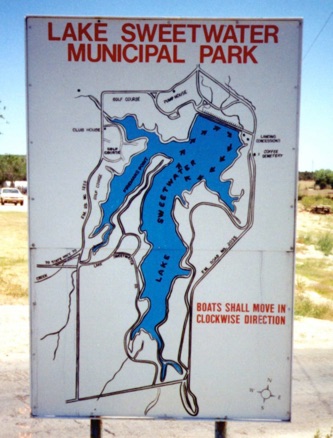
This sign at Lake Sweetwater shows the layout of the lake
(Photo by author; May 13, 2000).
Scenes from the Dedication Of Lake Sweetwater in 1934
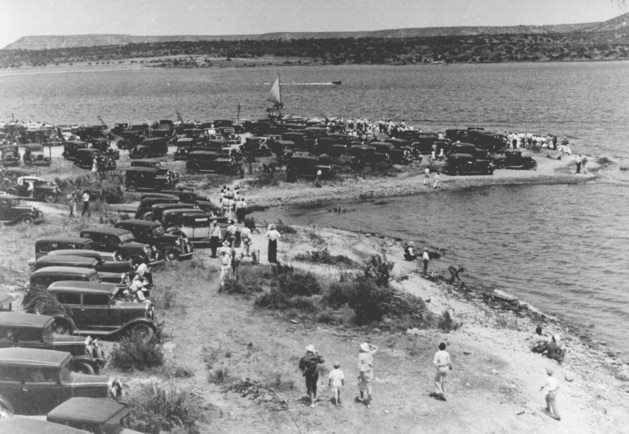
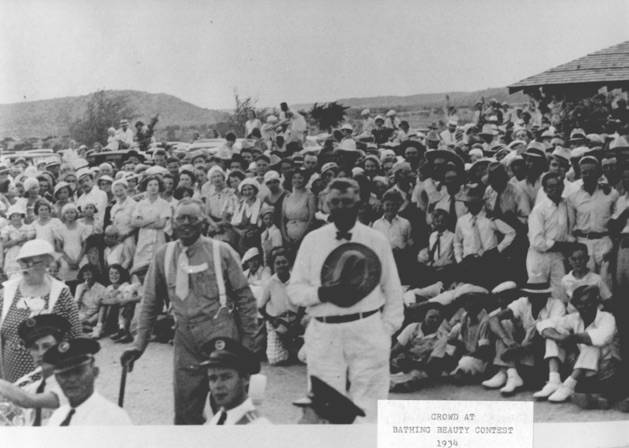
Dedication of Lake Sweetwater in 1934. The photo at top shows part of the crowd that gathered to watch
boat races at Lake Sweetwater. The photo at the bottom shows a crowd gathered for a bathing beauty
contest (Photos courtesy of the Pioneer Museum in Sweetwater, Texas).
Lake Sweetwater: At a Distance and Up Close
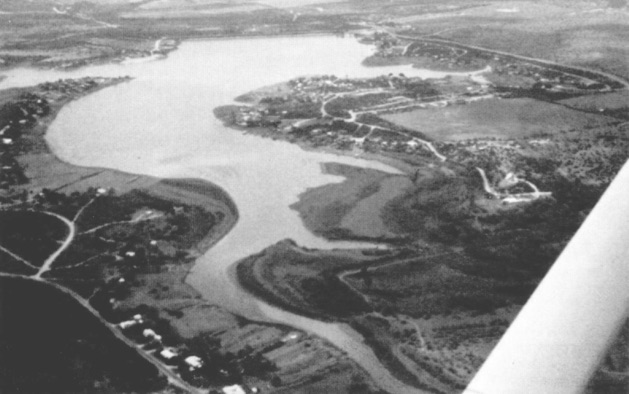
Aerial view of Lake Sweetwater.
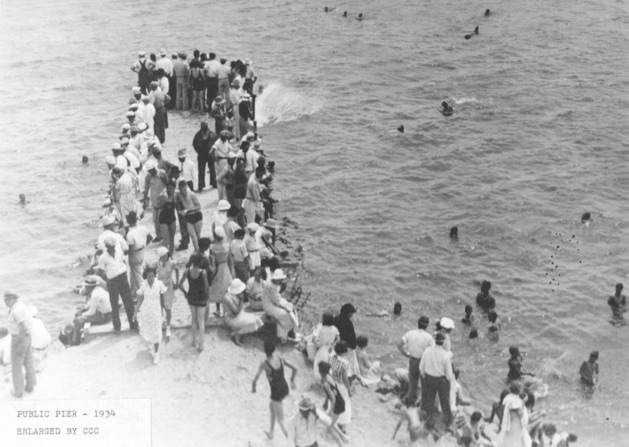
Photo of public pier taken in 1934 – a pier that no longer exists
(Courtesy of the Pioneer Museum in Sweetwater, Texas).
More Scenes from Lake Sweetwater
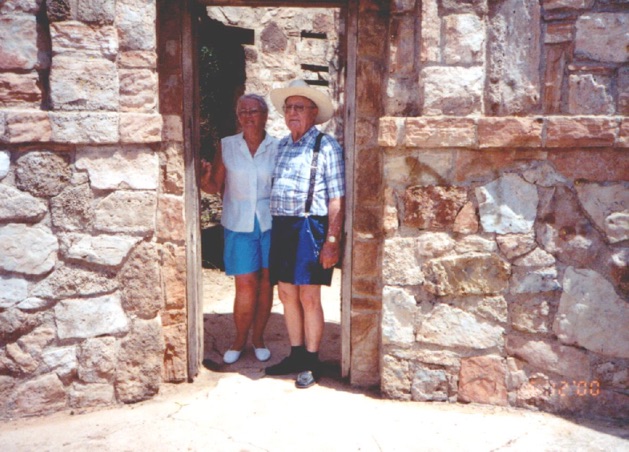
Howard & Erma Barnhill in the amphitheater at Lake Sweetwater
(Photo by author: June 12, 2000).
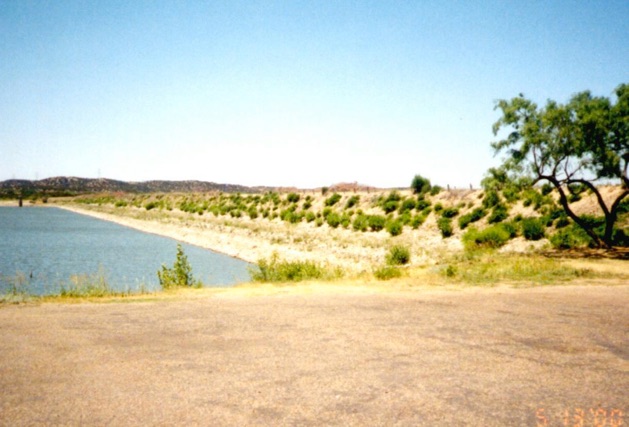
The dam at Lake Sweetwater (facing west). When this photo was taken,
the lake was low due to a drought (Photo by author; May 13, 2000).
1 Sweetwater Daily Reporter, 7 September 1932, 1.
2 Minutes of Ordinance, Volume 6, City of Sweetwater: May 21, 1925 to May 26, 1930. Entry for March 11, 1929. Pages 457-459.
3 Unpublished and undated article by Beth Wortham found in the Archive Room of the Pioneer City-County Museum in Sweetwater,
Texas. See also interview by Louise Bradford with John Ford on August 16, 1933.
4 Nolan County News, 10 June 1934, 4.
5 Minutes City Ordinance, Volume 7, City of Sweetwater: June 9, 1930 to March 23, 1936. Page 68.
6 Sweetwater Daily Reporter, 7 September 1932, 1.
7 Nolan County News, 1 September 1932, 1. Sweetwater City Engineer J. C. Morris, Jr., while surveying for Lake Sweetwater in October, 1930 (Courtesy of the Pioneer Museum in Sweetwater, Texas). Patsy (Armstrong) Hefner remembers living at Lake Sweetwater while her father, Walter W. Armstrong, worked as the lake keeper (Photo by author; June 6, 2000).
8 Nolan County News, 14 June 1934, 1.
Copyright 2007, Travis Monday. Used with permission.
This article is an excerpt from Travis Monday’s 495 page book about the history of Nolan County titled “Ultimate Museum Musings”. “Ultimate Museum Musings” contains the complete collection of 62 articles with photos previously published by the author in the Sweetwater Reporter in Sweetwater, Texas, about the history of Nolan County, Texas, and the surrounding area. Includes an index and additional articles and chronologies designed especially for researchers and family historians. Topics include: Women Airforce Service Pilots (WASP), Royal Air Force (RAF), Double Heart Ranch and Rodeo, Harley Sadler, Lew Jenkins, Elvis Presley, Sweetwater Fire Department, Law Enforcement Stories (Lawmen & Outlaws), Cowboys and Indians, Frank Hamer, Drive In Theaters, Pan Zareta, Coca-Cola, Hospitals and Courthouses of Nolan County, Grogan Wells, Santa Fe Roundhouse, C-47 Airplane Crash, S. D. Myres, Salty Pups Football Team (Sweetwater Mustangs), Dorothy Scarborough (The Wind), Mulberry Mansion,Otto Carter, P-47, gliders, and more.
The book may be purchased online from LuLu.com. http://www.lulu.com/content/818474


For more history click here >>
Summer 2009 - 75th Anniversary of Lake Sweetwater Municipal Park
The summer of 2009 marked the 75th anniversary of the formal opening and dedication of the Lake Sweetwater Municipal Park. The lake portion of Lake Sweetwater was started in 1929 and finished in 1930 but the construction of the adjacent park areas took much longer. The official dedication and formal opening of both the lake and its park areas did not happen until 14 June 1934.
Lakes and parks were still uncommon in West Texas in the 1930s and the opening of Lake Sweetwater was considered a big deal back then. The completion of the lake and its park merited a big Sweetwater and West Texas celebration that began at 9 a.m. on Thursday, 14 June, 1934 with a parade from the city square to the lake of more than 100 automobiles, selected to depict the growth of Sweetwater by years. The parade's arrival at the lake park kicked off a one hour concert by the Sweetwater Municipal Band. A dedication ceremony followed at 11 o'clock under the direction of Ed Mays, local attorney. At 1 p.m. a second band concert introduced speeches by prominent state officers and state commissioners. Later that afternoon candidates for Congress spoke. A boat parade and the christening of a Sea Scout sailboat by Miss Evangeline Sheridan was held at 2:30 p.m.. Motor boat races were held throughout the day as well as two baseball games. The baseball games, which pitted Champion vs. Divide and Busby vs. Roscoe., were held in a ball park then present on the now empty field located along the western edge of today's camp grounds below the dam. The then recently completed nine hole golf course was also opened to visitors. That night 45 cabin owners along the lake shore held open houses and entertained prominent West Texans. A fireworks display at 9:30 p.m. and a Legion dance closed the first day festivities.
The Sweetwater Municipal Band led off the second day of observances at the lake with a 9 a.m. concert on Friday morning, 15 June. Trent battled Loraine later that morning in the first of two baseball games that day. More speeches began at 11 a.m. at the park and were followed by a free to all barbecue from 12 to 1 o'clock. Twenty five prime beeves had been donated by West Texas stockmen for the 20,000 spectators that were expected for the event. Speeches resumed in the afternoon with appearances by candidates for governor. Motor boat races were again held in the morning and afternoon. Friday's events were climaxed by a “bathing girl review” held at 5:45 p.m. near the entrance to the lakeshore municipal park at what was then an impressive municipal public clubhouse. Miss Virginia Cushing of Big Spring - described in local newspapers as "a particularly appealing blonde" - placed first among 28 contestants, receiving a prize of $25, a silver loving cup, and the title of "Miss West Texas". Second and third place prizes went to Miss Josephine Boyd of Fort Worth and Miss Martha Jane Bryant of Stamford. The day closed with another evening Legion dance.


